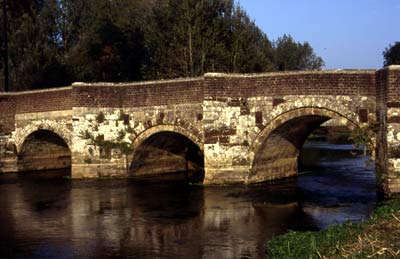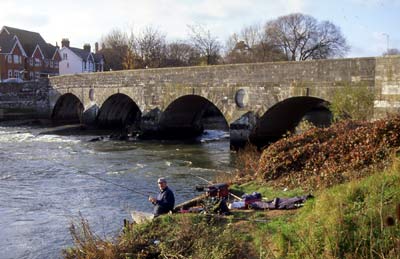| MARK WINTLE |
| Mark Wintle, an angler for thirty-five years, is on a quest to discover and bring to you the magic of fishing. Previously heavily involved with match fishing he now fishes for the sheer fun of it. With an open and enquiring mind, each week Mark will bring to you articles on fishing different rivers, different methods and what makes rivers, and occasionally stillwaters, tick. Add to this a mixed bag of articles on catching big fish, tackle design, angling politics and a few surprises. Are you stuck in a rut fishing the same swim every week? Do you dare to try something different and see a whole new world of angling open up? Yes? Then read Mark Wintle’s regular weekly column. |
FISH INTRODUCTIONS IN RIVERS
Recent discussions on the River Trent have highlighted the great variety of fish found there. One of the theories for the name of the river is that the river contains thirty different species. When J. W. Martin “Trent Otter” tried to name them, a century ago, he only just failed and had to include the unlikely turbot and mussels. Part of the reason for the historical distribution of coarse fish in our rivers goes right back to after the last ice age. It is thought that about ten thousand years ago, the eastern flowing rivers such as the Great Ouse, Trent and Thames flowed into the Rhine. Only these rivers originally had a wide distribution of species including fish such as rudd, silver and bronze bream and barbel. Some continental species such as ide and nase never made it in time.
Legacy of the Ice Age? The four rivers that I’m going to tell you about are the Hampshire Avon, the Dorset Stour, the Dorset Frome and the Dorset Piddle. The first two join in Christchurch Harbour, and the last two in Poole Harbour, and their close proximity makes the likelihood of similar fish populations highly likely. Furthermore, in the dim and distant past, it is thought that these four rivers were once part of the same river, known as the Solent River. Whether this was after the last ice age, I don’t know but it suggests that originally these rivers would have had very similar fish populations. Because the length of time between the end of the ice age and the flooding of the English Channel was comparatively short, there was not much time for all species to gain access to all rivers. This explains the difference in number of species between the eastern English rivers and those on the south and west coasts. It also suggests that the wide variances found now in the Hampshire and Dorset rivers are due entirely to artificial introductions since. The Original Species I think that the original species for these four rivers were dace, roach, pike, brook lamprey, stone loach, bullhead, minnow, trout plus the migratory trout, salmon, stickleback, and eels. Since then the following have been deliberately introduced: Avon: barbel, chub, grayling, perch, gudgeon, rainbow trout. Stour: barbel, chub, carp, perch, tench, bream, gudgeon, silver bream, rudd, grayling. Frome: perch, grayling, gudgeon, rudd, bream. Piddle: grayling? Add in accidental stockings: Avon: carp, tench, rudd, orfe. Stour: rainbow trout, bleak, sun-bleak? Frome: carp, tench, grass carp, rainbow trout. Piddle: perch, carp. By now, you should see that the widest variety of species is found in the Avon and Stour with less in the Frome and Piddle. It also demonstrates how difficult it is to keep track of what should be in each river, hence the difficulties faced by clubs trying to stock barbel. As barbel are held to non-native to the Avon, English Nature oppose their introduction though barbel have been present for about a hundred years. Similarly, consent was refused to stock crucian carp into a lake adjacent to the Avon in case they escaped though it is unlikely that crucians could over-run the Avon. What I’d like to do next is take each species in turn and try to explain when and where they were introduced.
Compared to some of the others this is relatively easy in that at least some documentary evidence does exit. Barbel expert and historian Peter Wheat has done most to find the evidence for the original stockings of barbel into the Stour and Avon. For the full story, you will need to try and get a copy of Waterlog No. 10. In brief, a consignment of 70 barbel caught from the Thames and stocked into the Stour at Iford Bridge in October 1898 by Tommy Gomm. In 1910, Gomm put another 38 in the same place. Legend has it that these fish spread to the nearby Avon (Iford is at the head of tidal part of the Stour and not a great distance from the Avon). But Peter Wheat uncovered evidence of another 50 being stocked and thinks these went into the Avon immediately below the Royalty, probably in 1898. The late Maurice Kausman once claimed to have been part of party that took a further consignment to Christchurch Quay in 1924. Back in 1973/4 a small number of barbel were transferred from Throop (illegally) to the Stour at Wimborne. Apart from this, their progress has been very slow up the Stour. In much more recent years, small barbel have been stocked further up the Stour, above Blandford. I have also heard rumours of other stockings in the upper Stour near Gillingham. On the Avon, the barbel have very gradually spread upriver as far as Salisbury, assisted by stockings at Ringwood, Downton and Longford during the 1950s. Chub Here lies a mystery. I once read that chub had only been stocked into the Stour and Avon some time in the early nineteenth century. English Nature apparently regard them as alien species in the Avon. There is certainly some anecdotal evidence that chub took until the 1950s to spread up to the headwaters on the Stour. On the Avon, the chub were universally despised for many years, not only by the salmon and trout anglers, but also by the roach anglers. All held the chub to be responsible for a variety of ills, and until as little as thirty years ago it was often the rule that anglers had to kill all chub. Again, its progress from the Christchurch area can be charted to a certain degree though chub made more rapid progress than on the Stour. The impediment to fish on the Stour compared to the Avon is the presence of many more mills and weirs. Even today, a fair number remain though two thirds of the mills have long disappeared. Tench A real mystery. I find it hard to believe that tench would occur naturally in the Stour. There is still a surprising head of them in several stretches, particularly above Blandford, though hardly anyone ever fishes for them. My suspicion is that monks introduced them. There are records of plenty of tench in the Stour in the 1600s. Some were even uncovered in an old mill pool on the Piddle. Grayling There is anecdotal evidence that grayling were introduced from the Test into the Avon in the early 1800s. How true this is has yet to be proved. It was common practice to remove unwanted fish (dace, roach, grayling) from the upper Avon and place them in the Stour and Frome in the post second world war years, and my suspicion is that this is how grayling got into the Stour. Grayling remain rare in the Stour as most of it is too slow for their liking. Similarly, I suspect grayling were also introduced into the Frome and did not get above Dorchester until the 1950s. There is reference to grayling in the Piddle in 1935 but whether this was true, or journalistic license, I don’t know because I’ve never seen any. The Grayling Society is trying to get a feel for the genetic strains of grayling in British rivers but cross-introductions such as these will complicate the task. Silver bream Gomm introduced silver bream into the Stour in 1912. They continue to thrive in the tidal reaches, but have never got upstream of Throop Mill. Most anglers that catch them refer to them as ‘hybrids’ being unable to recognise them. Bernard Venables told of many good-sized silver bream caught in the Royalty in the 1950s in his book ‘Angling Waters’, though it seems silvers are no longer present in the Avon. Bleak and sun bleak Two less than welcome fish. The bleak got into the Stour from London anglers’ livebait buckets after the Second World War. The weirs have hampered their progress upstream, and they have failed to get as far as Blandford. Sun bleak or ‘motherless minnows’ have spread across Somerset and are rumoured to have reached one of the headwater streams of the Stour. The Environment Agency is endeavouring to track them down and remove them but will it be too late? Perch Perch have been widespread in the Stour and Avon for many years, though decimated by perch disease in the mid seventies. There has been a very strong comeback on the Stour in recent years, with fish to nearly four pounds reported. Amazingly, Wareham DAS stocked perch, bream and gudgeon into the Frome in 1935. To this day, there are some perch in the Frome, with the odd big one. The bream all but disappeared during the forties until Ray Selby caught a 9-2 fish in 1952. Today the odd escapee bream from lakes is present. The gudgeon are still about. Others I cannot cover all of the many other stockings, legal or illegal, deliberate or accidental, but I hope I given a flavour of the complex goings on that contribute to the very mixed stock that is present nowadays. For example, there have been many deliberate stockings of bream on the Stour. I do have details of many other stockings, but even I cannot explain catching a rudd from the Avon last season, the rudd in the lower Stour (not from the 1912 stocking that failed) that have appeared in the last three years, and the fact that my best ever rudd came from the Frome. If anyone does need more information for research, or has more information then please get in touch. Finally, thanks to the Grayling Society for their assistance in preparing this article. NEXT WEEK: ‘Fickle Crucians’ |















